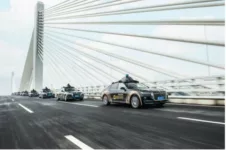GM CEO Mary Barra and Kyle Vogt, CEO of Cruise, GM subsidiary autonomous driving company, attended the conference “Featured Session: Self-Driving Cars: From Science Fiction to Scale” to discuss the future of self-driving vehicles recently. Kyle Vogt said he really admired the Chinese government for “keeping the regulation wide open”, formulating various policies to facilitate the construction of road information technology infrastructure, and creating space for the development of intelligent connected vehicles and autonomous driving vehicles.
A Chinese tech company has done what Kyle Vogt wanted to do but couldn’t. On March 22, MOGO AI released an autonomous driving video, which may be the world’s first-ever L4 autonomous driving relying solely on MOGO AI Station 2.0, the roadside intelligent station independently developed by the company. MOGO AI Station 2.0 has been massively deployed in Hengyang City, Hunan, China, and formed a 38-km long digital road section. It is the latest example of the Chinese government’s years-long effort to encourage the construction of new infrastructure.
The video released by MOGO AI is quite different from previous ones. MOGO AI masked all sensors on the vehicle and relies solely on the roadside intelligent station to achieve L4 autonomous driving on urban open roads. Autonomous driving actions include accessing traffic light status, pedestrian warning, road condition warning, front-car braking warning, right-of-way gambling, acceleration, overtaking, autonomous lane changing, etc.
According to statistics, average per day, MOGO Al Station 2.0 on Hengyang City digital road processes data flow of 46.20 TB, analyzes perception data of 1.85 billion frames, identifies 1.96 million traffic participants, sends traffic light status for 25.92 million times, computes V2X events for 2.37 billion times and conducts vehicle-road interaction for 27.37 million times. To this day, there are 5,000 intelligent connected vehicles interacting with Mogo AI Station 2.0 on a daily basis.
Throughout the world, the development of science and technology is the megatrend. In China, big data, cloud computing, the Internet, and other technologies closely related to artificial intelligence have a favorable atmosphere and enjoy rapid development. As the most advanced technology in the automobile industry, autonomous driving is one of the main application scenarios of artificial intelligence.
Autonomous driving relies on computers, artificial intelligence, and other technologies. Without the physical operation of a human driver, the vehicle can navigate, make decisions and control itself to realize safe driving. In a special report on autonomous driving launched by KPMG, autonomous driving has become a hot area of investment concern in the capital market.
In fact, the technological paths chosen by autonomous driving companies in China and US are quite different. For example, Tesla and Waymo in the US take the route of autonomous driving of a vehicle, while MOGO AI in China takes the route of “vehicle intelligence plus vehicle-road interaction” which links all traffic participation elements, including the vehicle, the smart road and the AI cloud together, so as to provide more comprehensive traffic information for intelligent connected vehicles and improve the safety of autonomous driving.
It is known that MOGO AI is China’s leading full-stack technology and operation service provider for autonomous driving, which has successfully built the industry-leading “vehicle-road-cloud integrated” system. With a product package including AI digital road stations, ICV data services, and autonomous driving vehicles and services, MOGO AI comprehensively boosts digital road construction and the large-scale application of intelligent connected vehicles, which can be rapidly and massively deployed in urban open roads, highways, scenic spots, and parks.








